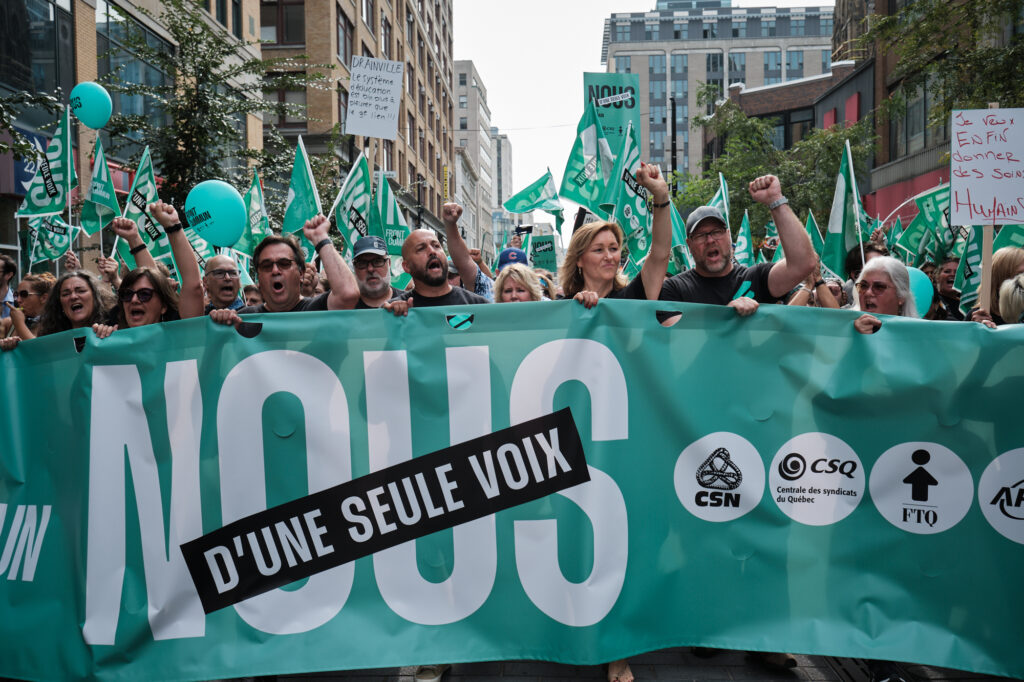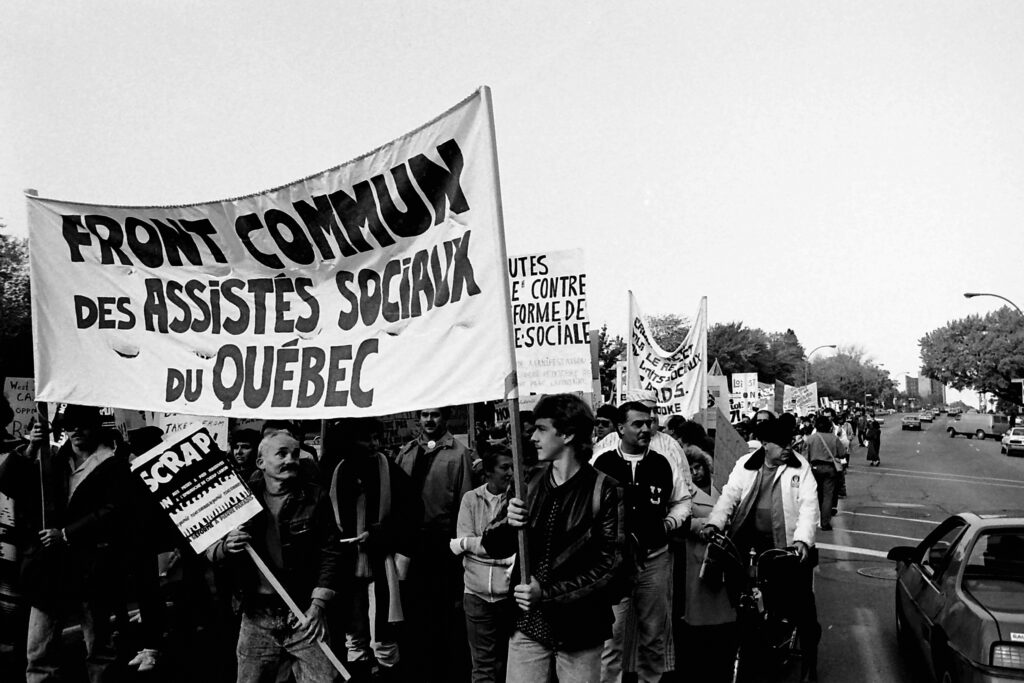Public sector strike on the horizon in Québec


Over the next few months, there probably will be a major confrontation between the Québec government and public sector unions, the likes of which we have not seen since at least 2004, and possibly since the 1980s. One clear sign of that dynamic is the demonstration by one hundred thousand workers on September 23 in Montreal, on a Saturday. Several factors are leading in that direction: first, the arrogance of a bosses’ government determined to have their way; second, the accumulated frustration and outrage of public sector workers after decades of neglect and the slow erosion of public services; third, the sympathy of broad sections of the population for the people who have kept public services going during the pandemic and beyond.
The government
The government of François Legault—founding leader of the Future of Québec Coalition (Coalition avenir Québec – CAQ) and prime minister since 2018—is mostly made up of people who were executives in the private sector before getting into politics, including Legault himself who was CEO of an airline. Collectively, they are always on the side of landlords against tenants (most of them being landlords themselves), on the side of oil and gas companies against the climate, and in favor of roads and bridges instead of public transit, etc. It is a conservative party akin to moderate Republicans or the most right-wing Democrats in the United States. His government is Québec nationalist without being for independence, the most common political position for Québec governments since the 1880s.
The CAQ is a very recent political coalition with a very vague basis of unity, which was explicitly created to bring together former Liberals—unhappy with the turn of their party towards unconditional support for federalism (or Canadian unity)—and former Parti québécois (PQ) members (including Legault, a former PQ minister of Education) who were willing to give up the goal of sovereignty for the foreseeable future. But their autonomism remains very symbolic, with very few gains since they took power. Mostly, they have targeted migrants and religious minorities in the name of secularism and Québec nationalism, claiming to oppose racism while stubbornly refusing to recognize its systemic nature.
The last round of public sector negotiations took place at the height of the pandemic in 2020. The deals reached separately by the unions (there was no common front, or united coalition of unions, at that time) were for a three-year contract instead of the usual five and involved few gains from the last collective agreements of 2015. It seemed then that the government had decided to avoid a confrontation that would add to the crisis caused by the coronavirus, and to aim instead for a rematch soon after the general election of 2022. Having been reelected in October 2022 with an increased majority at the National Assembly,1 the CAQ government is now attempting to achieve the sought-after historic gains against the unions that they abandoned three years earlier.
The unions
Having anticipated that this current fight would be harder, four of the main unions representing public sector workers decided to form a Common Front (Front commun), meaning that they bargain together on common issues like wages, pensions, and family leave. Together, those four organizations (FTQ, CSN, CSQ and APTS), represent 420 thousand workers, about seventy percent of whom are women. They work in health care, social services, education, and other services managed by the province. Other unions outside the Front commun represent some of the teachers (FAE) and most nurses (FIQ). In total, more than half a million workers are currently bargaining with the province.
The Front commun is asking for a three-year contract with wage increases about two percent over inflation each year. The government has responded with an offer of nine percent total over five years, which is obviously below inflation rates based on the government’s own predictions. It is also attacking pensions in order to punish people for retiring “early,”2 which is in line with their approach to solving the shortage of qualified people in many professions through coercion. At the many tables negotiating working conditions and other issues specific to each sector, there has been no movement on the part of the employer to meet any of the unions’ demands. But as a first “concession,” the minister in charge of government spending announced recently that the employer was going to prioritize its own demands. This announcement was made after the giant demonstrations and as the strike votes started.
A bit of history
The first Front commun was formed in 1972 and included most provincial public sector workers. This was after decades of bitter union struggles in the private sector and against successive governments, in a period of upheaval at a global level. During that strike, the leaders of the three main unions were sent to prison for encouraging their members to go on strike, in spite of a court injunction making those walkouts illegal. The charge was contempt of court and the sentence a whole year in prison. The outrage at that level of repression brought many private sector unions into the movement, with striking workers even taking over some of the towns. This was probably the highest level of class struggle anywhere in Canada at any point in time.

Ten years later, the PQ government of René Lévesque (sovereigntist and center left) decided to make public sector workers pay for the recession at the time. It imposed contracts through legislation and adopted a harshly punitive law banning strikes. This was the same government who, a few years earlier, adopted a law banning scabs and had several union activists in its caucus and cabinet. The sense of betrayal was even more demoralizing than the laws themselves. As a result, tens of thousands of workers left the PQ.
It could be argued that the Québec labor movement never got over this historic defeat. In the following decades, the leadership of the movement adopted a new strategic vision, going from a combative, class-struggle approach (syndicalisme de combat) to one centered on constant dialogue with governments and employers (concertation conflictuelle). During those forty years, public services have been undermined by rampant privatization, the introduction of management models taken from the manufacturing sector, the centralization of management structures, and the erosion of wages and working conditions.
Challenges for the Left
There hasn’t been an explicit return to a class-struggle strategy in the movement. The only reason we are looking at a possible major confrontation is the government’s determination to impose further setbacks on already disgruntled workers. It is still possible that either the government will make significant concessions before the strike or that the leadership will bring a mediocre settlement to its members in order to avoid having to manage an explosive mobilization. The fact that strike mandates are basically blank checks for the leadership to do as they wish in terms of the timing and duration of work stoppages means it will be very difficult to oppose any deal down the road and keep the struggle going.
This makes the expansion and coordination of rank and file networks across sectors in each locality and region an urgent task, as always. Québec solidaire is a broad left political party with 15 thousand members.3 The Québec solidaire union activists’ network (Réseau intersyndical) has good momentum at the moment and could play a role. Existing networks from previous attempts at rank and file organizing (like Lutte commune, a network of Left union activists of various political persuasions) can also be helpful. But it is unlikely that such efforts will lead to a large enough organized base to make a significant difference in the short term.
Québec solidaire can contribute in other ways, like the interventions of its MNAs (Members of the National Assembly) and its national spokespeople. Some of that is already happening, including explicit links being made between the party’s campaigning on inflation and the wage demands of the unions. The very vocal opposition of the QS caucus of MNAs to the wage increase of $30,000,4 which most parliamentarians adopted for themselves last fall, was also important.
But the leadership of the party has, to date, been reluctant to confront the union bureaucracy’s conservatism in any way. So it is up to other structures in the party, like the union activists’ network and local associations, to play this role.
Another key issue is whether the government could try to impose contracts like the PQ did in 1982. An obstacle to that scenario is a recent Supreme Court of Canada ruling regarding public sector unions in Saskatchewan, which clarified the right to strike and collectively bargain. If we get to that level of conflict, it will be important to mobilize at the pan-Canadian and international level. There was the beginning of a mobilization in Québec last year when the Ontario government tried to force education support workers back to work. The resolution of that conflict preempted what could have been an historic level of class solidarity across provincial borders. Raising awareness of this struggle in the United States could also be useful, both to the movement in Québec and to union activists and the Left in the U.S.
Featured image credit: Djof; modified by Tempest.
Categories
We want to hear what you think. Contact us at editors@tempestmag.org. And if you've enjoyed what you've read, please consider donating to support our work:
DonateBenoit Renaud View All
Benoit Renaud is a long-time socialist based in Gatineau, Québec who has been involved in Québec Solidaire from the beginning, including as a candidate and a member of the leadership. He is currently working as a teaching adviser and is a member of the Educational Professionals Federation (FPPE-CSQ), one of the many unions affiliated with the Common Front.
